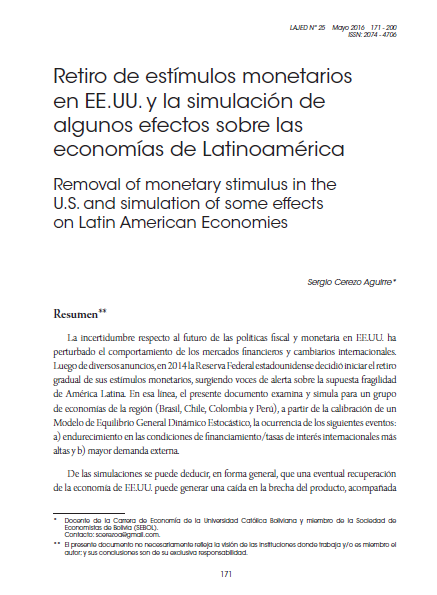Removal of monetary stimulus in the U.S. and simulation of some effects on Latin American Economies
DOI:
https://doi.org/10.35319/lajed.20162566Keywords:
Macroeconomic outlook, monetary policy, dynamic stochastic general equilibrium modelsAbstract
Uncertainty about the future of fiscal and monetary policies in the United States has disrupted the behavior of international exchange and financial markets. After several announcements, in 2014 the US Federal Reserve decided to begin the gradual removal of monetary stimulus, generating voices of warning about the supposed fragility of Latin America economies. In this sense, this paper examines and simulates those effects on a group of economies in the region (Brazil, Chile, Colombia and Peru). For that purpose, a calibrated Dynamic Stochastic General Equilibrium model is employed, and the following events are analyzed: a) tightening of financing conditions/higher international interest rates; and b) greater external demand. From the simulations, we can deduce that an eventual recovery of the U.S. economy can generate a fall in the output gap accompanied by minor inflationary pressures in Latin American countries, given an increase in international interest rates. However, increased external demand, as a consequence of this recovery, would generate a rebound in the output gap and inflationary pressures in the region. The final effect on GDP and inflation will depend on which of the two effects is more important and the ability to react as well as the fundamentals of each economy.
Downloads
References
Álvarez, J. C. P. 2008. “Hechos estilizados de la economía colombiana: fundamentos empíricos para la construcción y evaluación de un modelo”. DSGE. Banco de la República, Colombia.
Banco de Colombia. 2013. “Posibles implicaciones de la normalización de la política monetaria de los Estados Unidos sobre las economías emergentes”. Serie Reportes del emisor, N° 173, octubre.
Banco Central de Bolivia. 2013. Resultados “Encuesta sobre flujos de capital”. La Paz, Bolivia.
Banorte BID. 2014 “Retos de Latinoamérica ante el tapering del FED y la desaceleración de China”. Análisis Económico de Latam, Abril, México. Extraído de: http://casadebolsabanorteixe.com/analisis/flashes/Economicos/Nota_BID2014_RetosLatam.pdf
Calvo, G.A. 1983. “Staggered prices in a utility maximizing framework”, Journal of Monetary Economics, 12 (3), 383-398.
Castillo, P., C. Montoro, y V. Tuesta. 2006. “Un modelo de equilibrio general estocástico estimado con dolarización: un enfoque bayesiano (MEGA-D)”. Banco de la Reserva del Perú, Subgerencia de Investigación.
------ 2009. “Un modelo de equilibrio general con dolarización para la economía peruana”, Estudios económicos, N° 17. Banco de la Reserva del Perú.
CEPAL. 2013. “La coyuntura económica internacional y sus consecuencias macroeconómicas para América Latina y el Caribe”. Informe de la División de Desarrollo Económico.
Corsetti, G. y P. Pesenti, 2005. “International Dimensions of Optimal Monetary Policy”. Journal of Monetary economics, 52(2), 281-305
De Castro, M. R., S. N. Gouvea, A. Minella, R. Santos y N. F. Souza-Sobrinho. 2011. “SAMBA: Stochastic analytical model with a bayesian approach”, Brazilian Review of Econometrics, 99(99).
Devereux, M. B. y C. Engel. 2003. “Monetary Policy in the Open Economy Revisited: Price Setting and Exchange-Rate Flexibility”. The Review of Economic Studies, 70(4), 765-783.
Florian, D. y C. Montoro. 2009. “Development of MEGA-D: A DSGE Model for Policy Analysis”. Banco Central de Reserva del Perú.
Gali, J. y T. Monacelli. 2005. “Monetary Policy and Exchange Rate Volatility in a Small Open Economy”, Review of Economic Studies, 72(3), 707-734.
Lane, P. R. 2001. “The new open economy macroeconomics: a survey”, Journal of international economics, 54(2), 235-266.
Liu, P. 2006. “A small new Keynesian model of the New Zealand economy”. Reserve Bank of New Zealand Discussion Paper, 3.
Ledesma, A. 2010. “Un modelo para una economía pequeña y abierta”. Word Press, Monetaria 03
Lemgruber, C. 2010. “Economic Growth, Potential Output and Inflation in Brazil”, mimeo. Extraído de: http://www.economonitor.com/blog/2010/06/brazil-economic-growth-potential-output-and-inflation/.
Medina, J.P. y C. Soto. 2005. “Oil Shocks and Monetary Policy in an Estimated DSGE Model for a Small Open Economy”. Working Paper, Banco Central de Chile, 353.
------ 2006. “Model for Analysis and Simulations: A Small Open Economy DSGE for Chile”. Conference Paper, Central Bank of Chile.
Obstfeld, M. y K. Rogoff. 2005. “Exchange rate dynamics redux”, Journal of Political Economy, 103 (3), 624-60, University of Chicago Press.
Paoli, Bianca de. 2009. “Monetary policy and welfare in a small open economy”. Journal of international Economics, 77(1), 11-22.
Parra. 2008. “Hechos estilizados de la economía colombiana: fundamentos empíricos para la construcción y evaluación de un modelo DSGE”. Borradores de Economía, Banco de Colombia.
Philip, L. 2006. “A small new Keynesian model of the New Zealand economy”. Reserve Bank of New Zealand, Discussion Paper Series, 03.
Restrepo, J.E. y C. Soto. 2004. Regularidades empíricas de la economía chilena”. Banco Central de Chile, Working Papers N° 301, diciembre.
Yang, L. y G. Vasco. 2008. “An Estimated DSGE Model of an Emerging Economy with Financial Market Imperfections”. University of Surrey y NIPE-UM.






